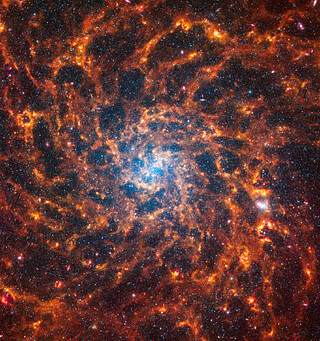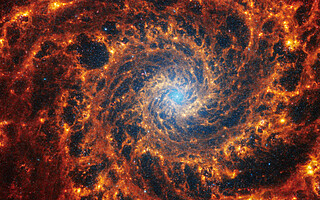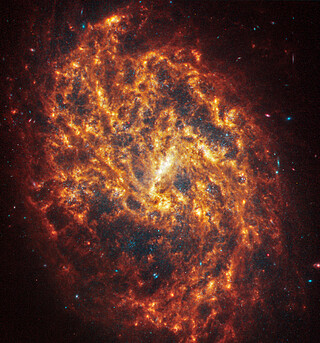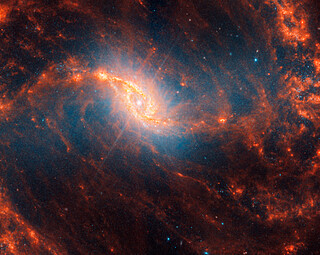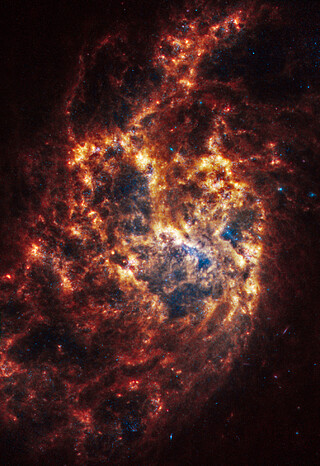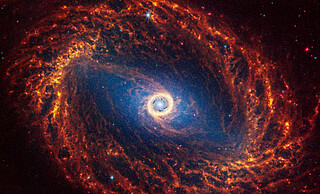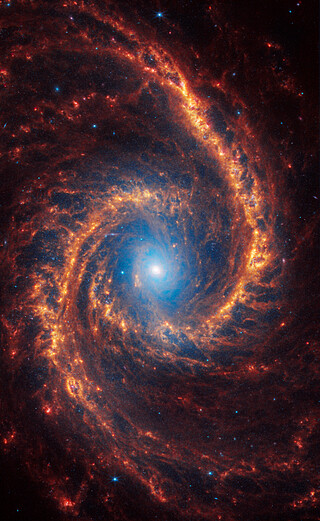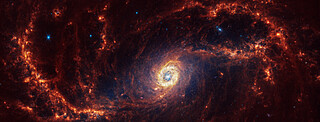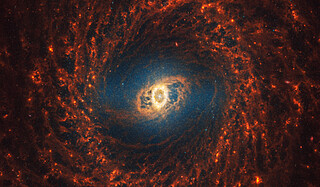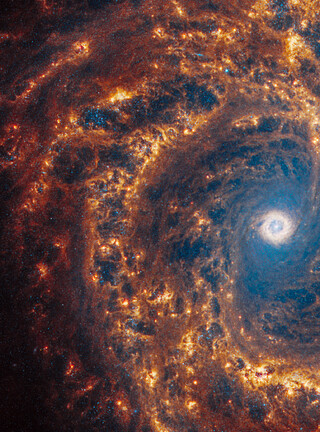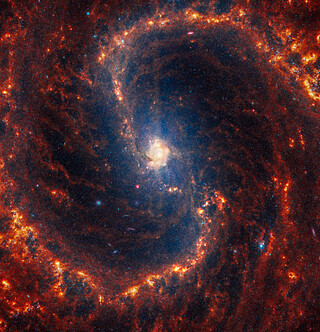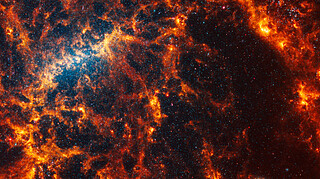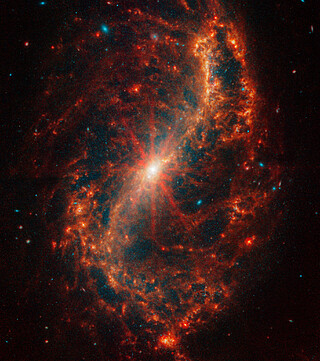weic2403 — Photo Release
Webb depicts staggering structure in 19 nearby spiral galaxies
29 January 2024
A new treasure trove of images from the NASA/ESA/CSA James Webb Space Telescope showcases near- and mid-infrared portraits of 19 face-on spiral galaxies. This new set of exquisite images show stars, gas, and dust on the smallest scales ever observed beyond our own galaxy. Teams of researchers are studying these images to uncover the origins of these intricate structures. The research community’s collective analysis will ultimately inform theorists’ simulations, and advance our understanding of star formation and the evolution of spiral galaxies.
If you follow each of the galaxy’s clearly defined arms, which are brimming with stars, to their centres, there may be old star clusters and – sometimes – active supermassive black holes. Only the James Webb Space Telescope can deliver highly detailed scenes of nearby galaxies in a combination of near- and mid-infrared light – and a set of these images were publicly released today.
These Webb images are part of a large, long-standing project, the Physics at High Angular resolution in Nearby GalaxieS (PHANGS) programme, which is supported by more than 150 astronomers worldwide. Before Webb took these images, PHANGS was already brimming with data from the NASA/ESA Hubble Space Telescope, the European Southern Observatory's Very Large Telescope’s Multi-Unit Spectroscopic Explorer, and the Atacama Large Millimetre/submillimetre Array, including observations in ultraviolet, visible, and radio light. Webb’s near- and mid-infrared contributions have provided several new puzzle pieces.
Webb’s NIRCam (Near-Infrared Camera) captured millions of stars in these images, which sparkle in blue tones. Some stars are spread throughout the spiral arms, but others are clumped tightly together in star clusters.
The telescope’s MIRI (Mid-Infrared Instrument) data highlights glowing dust, showing us where it exists behind, around, and between stars. It also spotlights stars that haven’t yet fully formed – they are still encased in the gas and dust that feed their growth, like bright red seeds at the tips of dusty peaks.
To the amazement of astronomers, Webb’s images also show large, spherical shells in the gas and dust that may have been created by exploded stars.
The spiral arms’ extended regions of gas also reveal details in red and orange. Astronomers study the spacing of these features to learn how a galaxy distributes its gas and dust. These structures will provide key insights about how galaxies build, maintain, and shut off star formation.
Evidence shows that galaxies grow from inside out – star formation begins at galaxies’ cores and spreads along their arms, spiralling away from the centre. The farther a star is from the galaxy’s core, the more likely it is to be younger. In contrast, the areas near the cores that look lit by a blue spotlight are populations of older stars. The galaxy cores that are awash in pink-and-red diffraction spikes may indicate an active supermassive black hole or saturation from bright star clusters toward the centre.
There are many avenues of research that scientists can begin to pursue with the combined PHANGS data, but the unprecedented number of stars Webb resolved are a great place to begin. In addition to immediately releasing these images, the PHANGS team has also released the largest catalogue to date of roughly 100 000 star clusters.
More information
Webb is the largest, most powerful telescope ever launched into space. Under an international collaboration agreement, ESA provided the telescope’s launch service, using the Ariane 5 launch vehicle. Working with partners, ESA was responsible for the development and qualification of Ariane 5 adaptations for the Webb mission and for the procurement of the launch service by Arianespace. ESA also provided the workhorse spectrograph NIRSpec and 50% of the mid-infrared instrument MIRI, which was designed and built by a consortium of nationally funded European Institutes (The MIRI European Consortium) in partnership with JPL and the University of Arizona.
Webb is an international partnership between NASA, ESA and the Canadian Space Agency (CSA).
Image Credit: NASA, ESA, CSA, STScI, J. Lee (STScI), T. Williams (Oxford), PHANGS Team, E. Wheatley (STScI)
Links
- ESA Webb Seeing Farther Interactive Brochure
- Release on STScI website
- Release on ESA website
- Release on NASA website
- PHANGS-JWST webpage
Contacts
Bethany Downer
ESA/Webb Chief Science Communications Officer
Email: [email protected]
Ninja Menning
ESA Newsroom and Media Relations Office
Email: [email protected]
About the Release
| Release No.: | weic2403 | |
|---|---|---|




